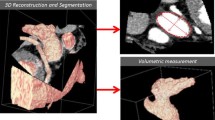Abstract
Objective
Accumulating evidence points to the central importance of the posterior left atrium (PLA) for atrial fibrillation (AF). Catheter ablation intended to cure AF is increasingly practiced; performance and assessment of this procedure is enhanced by accurate imaging of PLA anatomy. Prior reports have suggested that both computed tomographic (CT) and magnetic resonance (MR) imaging techniques provide accurate PLA images. These techniques have never been compared directly.
Materials and methods
Twenty patients referred for catheter ablation underwent preoperative imaging using both CT and MR. Each technique was used to create a multidimensional image of the PLA.
Results
Within patients, morphologic and dimensional PLA indices, including number of individual pulmonary venoatrial junctions, presence of ostial branches, circumference of each venoatrial junction, venoatrial junction “non-circularity”, and distance between ipsilateral superior and inferior venoatrial junctions, were well correlated.
Conclusions
CT and MR-based images of the PLA appear comparable. Technique selection should involve considerations of toxicity, tolerance, and local resources.
Similar content being viewed by others
References
Schwartzman, D., Lacomis, J., & Wigginton, W. (2003). Characterization of left atrium and distal pulmonary vein morphology using multidimensional computed tomography. Journal of the American College Cardiology, 41, 1349–1357.
Jongbloed, M., Bax, J., & Lamb, H. (2005). Multislice computed tomography versus intracardiac echocardiography to evaluate pulmonary veins before radiofrequency catheter ablation of atrial fibrillation: A head-to-head comparison. Journal of the American College of Cardiology, 45, 343–350.
Cronin, P., Sneider, M., Kazerooni, E., Kelly, A., Scharf, C., Oral, H., et al. (2004). MDCT of the left atrium and pulmonary veins in planning radiofrequency ablation for atrial fibrillation: A how-to guide. American Journal of Radiology, 183, 767–778.
Takase, B., Nagata, M., Matsui, T., Kihara, T., Kameyama, A., Hamabe, A., (2004). Pulmonary vein dimensions and variation of branching pattern in patients with paroxysmal atrial fibrillation using magnetic resonance angiography. Japanese Heart Journal, 45, 81–92.
Kato, R., Lickfett, L., Meininger, G., Dickfeld, T., Wu, R., Juang, G., et al. (2003). Pulmonary vein anatomy in patients undergoing catheter ablation of atrial fibrillation. Lessons learned by use of magnetic resonance imaging. Circulation, 107, 2004–2010.
Dill, T., Neumann, T., & Ekinci, O. (2003). Pulmonary vein diameter reduction after radiofrequency catheter ablation for paroxysmal atrial fibrillation evaluated by contrast-enhanced three-dimensional magnetic resonance imaging. Circular, 107, 845–850.
Mansour, M., Holmvang, G., & Sosnovik, D. (2004). Assessment of pulmonary vein anatomic variability by magnetic resonance imaging: Implications for catheter ablation techniques for atrial fibrillation. Journal of Cardiovascular Electrophysiology, 15, 387–393.
Tops, L., Bax, J., Zeppenfeld, K., Jongbloed, M., Lamb, H., van der Wall, E., et al. (2005). Fusion of multislice computed tomography imaging with three-dimensional electroanatomic mapping to guide radiofrequency catheter ablation procedures. Heart Rhythm, 2, 1076–1081.
Schwartzman, D. (2003). Catheter ablation to suppress atrial fibrillation: Evolution of technique at a single center. Journal of Interventional Cardiac Electrophysiology, 9, 295–300.
Schwartzman, D. (2004). The common left pulmonary vein: A consistent source of arrhythmogenic atrial ectopy. Journal of Cardiovascular Electrophysiology, 15, 560–566.
Juergens, K., Grude, M., Maintz, D., Fallenberg, E., Wichter, T., Heindel, W., et al. (2004). Multi-detector row CT of left ventricular function with dedicated analysis software versus MR imaging: Initial experience. Radiology, 230, 403–410.
Mahnken, A., Koos, R., Katoh, M., Spuentrup, E., Busch, P., Wildberger, J., et al. (2005). Sixteen-slice spiral CT versus MR imaging for the assessment of left ventricular function in acute myocardial infarction. European Radiology, 15, 714–720.
Hager, A., Kaemmerer, H., Leppert, A., Prokop, M., Blucher, S., Stern, H., et al. (2004). Follow-up of adults with coarctation of the aorta: Comparison of helical CT and MRI, and impact on assessing diameter changes. Chest, 126, 1169–1176.
Nonent, M., Serfaty, J., Nighoghossian, N., Rouhart, F., Derex, L., Rotaru, C., et al. (2004). Concordance rate differences of 3 noninvasive imaging techniques to measure carotid stenosis in clinical routine practice: Results of the CARMEDAS multicenter study. Stroke, 35, 682–686.
Lacomis, J., Wigginton, W., Fuhrman, C., Schwartzman, D., Armfeld, D., Pealer, K. (2003). Multi-detector row CT of the left atrium and pulmonary veins before radiofrequency catheter ablation for atrial fibrillation. Radiographics, 23, S35–S50.
Dickfeld, T., Calkins, H., Bradley, D., & Solomon, S. (2005). Stereotactic catheter navigation using magnetic resonance image integration in the human heart. Heart Rhythm, 2, 413–415.
Schwartzman, D., Kanzaki, H., Bazaz, R., & Gorcsan, J. (2004). Impact of catheter ablation on pulmonary vein morphology and mechanical function. Journal of Cardiovascular Electrophysiology, 15, 161–167.
Author information
Authors and Affiliations
Corresponding author
Additional information
Supported in part by an unrestricted grant from General Electric Healthcare.
Rights and permissions
About this article
Cite this article
Lacomis, J.M., Pealer, K., Fuhrman, C.R. et al. Direct comparison of computed tomography and magnetic resonance imaging for characterization of posterior left atrial morphology. J Interv Card Electrophysiol 16, 7–13 (2006). https://doi.org/10.1007/s10840-006-9016-6
Received:
Accepted:
Published:
Issue Date:
DOI: https://doi.org/10.1007/s10840-006-9016-6




